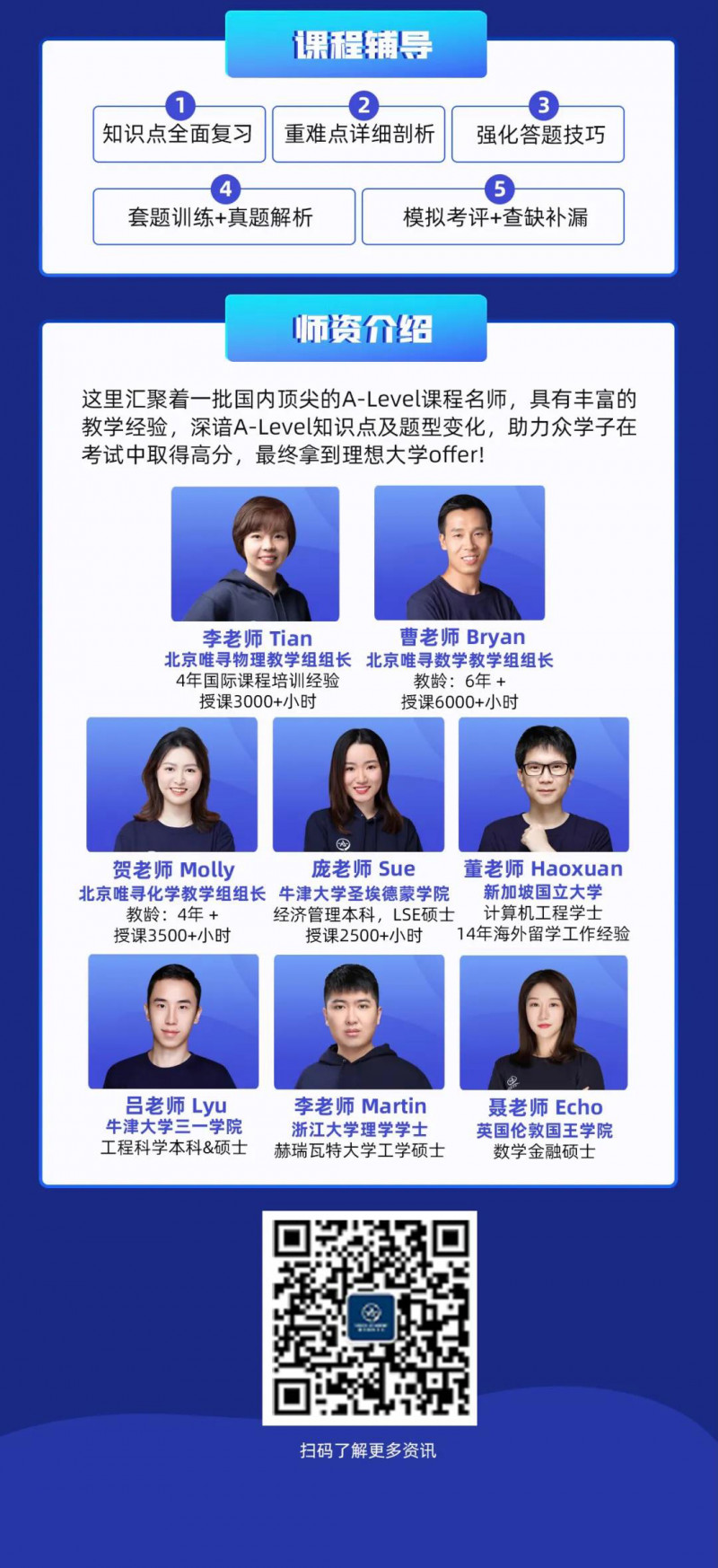
离国内的Alevel夏季大考还有几个月的时间,想拿A星的同学一定要提前复习。为了助力大家的复习,今天我们也给大家带来了一些知识点讲解。本期给大家讲解的是Alevel商务知识点财务和会计知识,一起来看看都有哪些吧!

The need for business finance
Setting up a business will require cash injections from the owners to purchase essential capital equipment and premises.This is called start-up capital.
All businesses need to finance their working capital - the day-to-day finance needed to pay bills and expenses and to build up stocks.
When businesses expand, further finance will be needed to increase the capital assets held by the firm.
Speicial situations will often lead to a need for greater finance.For example, a decline in sales as a result of economic recession,could lead to cash needs to keep the business stable.
Apart from purchasing fixed assets, finance is often used to pay for research and development into new products or to invest in new marketing strategies, such as opening up overseas markets or taking over another firm.
Capital expenditure:the purchase of assets that are expected to last for more than one year, such as building and machinery.
Revenue expenditure:spending on all costs and assets other than fixed assets and includes wages and materials costs.
Working capital is the 'lifeblood' of a business.Liquidity流动性 refers to the ability of a firm to be able to pay its short-term debts.
Liquidation清算:when a firm cease trading and its assets are sold for cash to pay suppliers and other creditors.
Sources of finance
Relationship between the legal structure and its sources of finance
Limited liability: favored more and have more choices
Unlimited liability:personal savings for most situations.
Short term finance and long term finance:
short:<12 months long:5-25 years
Business pays higher interest for longer terms, and interest rate might rise.
Mortgage按揭:loan to buy the building;
Bank can have more requirements;interest rate influence the mortgage.
Internal sources of finance内部融资渠道:
retained profits/earnings盈余利润: not for new business
sale of unwanted assets
sale and leaseback售后回租 of non-current assets
working capital
External sources of finance
Share capital:money raised through share.
New partners
Venture capital/VC风险投资、风投:risk capital invested in business start-ups or expanding small businesses that have good potential but do not find it easy to gain finance fom other sources.
Overdraft透支:bank agrees to a business borrowing up to an agreed limit as and when required.
Leasing租赁:obtaining the use of equpment or vehicles and paying a rental or leasing charge over a fixed period.
Hire purchase分期购买: an asset is sold to a company which agrees to pay fixed repayments over an agreed time period- the asset belongs to the company.This avoids making a large initial cash payment to buy the asset.
Bank loans
Mortgages
Debentures公司债券:bonds issued by companies to raise debt finance, often with a fixed rate of interest.
Microfinance小微金融: providing financial services for poor and low-income customers who do not have access to banking services, such as loans and overdrafts ed by traditional commercial banks.
Crowd funding众筹: the use of small amounts of capital from a large numer of individuals to finance a new business venture.
Government grants: there are many agencies that are prepared to grant funds to businesses.Grants often come with conditions attached, but don't have to be repaid if conditions are met.
Determinants
cost
flexibility
need to retain control
the use to which it is put
level of existing debt
Costs
The need for accurate cost data:
Cost is key factor in the 'profit equation'
Cost is of great importance to all departments
Allows comparisions to be made with past periods of time
Comparing cost data and calculating the cost of different options:
help managers to make decisions
past cost data can be used to set budgets for future
Types of costs: fixed, variable, marginal,direct and indirect
Direct costs:these costs can be clearly identified with each unit of production and can be allocated to a cost center.In manufacturing business,direct costs are labour and materials, while in service business it's the goods being sold.
Indirect costs: costs that cannot be identified with a unit of production or allocated accurately to a cost center.These are often referred to as overheads经费/营运开支.
Fixed costs固定成本:Costs that do not vary with output in the short run. Typical ones are rent, salary, heating and lighting, and insurance.
Variable costs可变成本:Costs that vary with output.e.g. raw materials,wages,and energy for machinery.
Marginal cost边际成本:The extra cost of producing one more unit of output.This will be the extra variable costs needed.
Problems of trying to allocate costs in given situations:
classification might be hard or even not worthwhile;
e.g. change in situation lead to unexpected cost that can't be judged.
Uses of cost information
1.How costs can be used for pricing decisions:
Use different pricing strategies;
Penetration pricing:low-high
Skimming:high-low
How costs can be used to monitor and improve business performance,including using cost information to calculate profits
a.Reduce the cost to improve profit margin
b.Always keep quality high
Break-even analysis:Determining the minimum level of output needed to break even or the profit made.P=AC
Margin of safety安全边际: the amount by which the sales level exceeds the break-even level of output.
If a firm is producing below the break-even point, it is in danger.
Formula: Production over break even point/break even output.
Advantages of break-even analysis:
determine a target profit level--establish the level of output required;
easy to construct and interpret;
making comparisons when constructing different options;

produce a precise result
assist managers to provide useful guidelines.
Limitations:
not all costs can be conveniently classified;
no allowance made for inventory levels on the break-even chart;
assuming all units produced are sold is impossible;
fixed costs are impossible to remain unchanged as output level changes.
Income statement损益表: records the revenue,costs and profit or loss of a business over a given period of time.
Balance sheet资产负债表/Statement of financial positon:The net worth or equity资产净值 of the company.This is the difference between the value of what a company owns(assets) and what it owes(liabilities).
Cash-flow statement现金流量表: Where cash was received from what it was spent on.
The sections of an income statement
The trading account营业账户
This shows how gross profit or loss has been made from the trading activities of the business.
Gross profit:equal to sales revenue less cost of sales
Sales revenue=P times Q
Cost of sales/direct cost=opening stocks plus purchases minus closing stocks
Profit and loss account section
This section of the income statement calculates both operating profit营业利润/net profit(profit before interest and tax)and profit for the year(profit after tax) of the business.
Appropriation account拨款账户
This section shows how the profit of the year is distributed between the owners(dividends or retained earnings)
Dividends分红:The share of the profits paid to shareholders as a return for investing.
Retained earnings/Retained profits盈余利润: The profit left after all deductions,including dividends, have been made, this is 'ploughed back' into the company as a source of finance.
The uses of income statements:
It can be used to measure and compare the performance of a business over time 纵向比较 or with other firms横向比较;
The actual profit data can be compared with the expected profit levels of the business;
Bankers and creditors of the business will need the information to help decide whether to lend money to the business;
Prospective investors may assess the value of putting money into a business from the level of profit being made.
Limitations:
Quality of the data shoud be considered
Classification of defferent kinds of profit is needed as some profits are low-quality profit and the other kind of profits is high-quality profit.
Low quality profit:one-off profit that cannot easily be repeated or sustained.
High quality profit: profit that can be repeated and sustained(well designed products leading to high sales)
Balance sheet: an accounting statement that records the values of a business's assets,liabilities and shareholders' equity at one point of time.
The aim of most businesses is to increase the shareholder's equity by raising the value of the business assets more than any increase in the value of liabilities.
Sources of shareholders' equity:
share capital股本
retained earnings
Shareholders' equity:total value of assets - total value of liabilities
Asset: an item of monetary value that is owned by a business
Liability: a financial obligation of a business that it is required to pay in the future
Share capital: the total value of capital raised from shareholders by the issue of shares.
Current assets vs. Non-current assets
Current assets流动性资产: assets that are likely to be turned into cash before the next balance-sheet date.
Non-current assets非流动性资产: assets to be kept and used by the business for more than one year.Also called 'fixed asset'固定资产.
e.g. land/buildings/vehicles/equipments/machinery---tangible
patents/good will良好的商誉--intangible fixed assets/intelletual property智慧财产
intellectual capital or property: the amount by which the market value of a firm exceeds its tangible assets less liabilities---an intangible asset.
Goodwill: arise when a business is valued at or sold for more than the balance-sheet value of its assets.
Current liabilities vs. Non-current liabilities
Current liabilities: debts of the business that will usually have to be paid within one year
Non-current liabilities: value of debts of the business that will be payable after more than one year.
Intangible assets无形资产: items of value that do not have a physical presence, such as patents, trademarks and so on.
Trade receivables(debtors)应收账款: the value of payments to be received from customers who have bought goods on credit.
Accounts payable(creditors)应付账款:value of debts for goods bought on credit payable to suppliers; also know as 'trade payables'
Inventories: stocks held by the business in the form of materials,work in progress and finished goods.
Working capital营运资本 (abbreviated WC) is a financial metric which represents operating liquidity available to a business, organization or other entity, including governmental entity. Along with fixed assets such as plant and equipment, working capital is considered a part of operating capital. Gross working capital equals to current assets. Working capital is calculated as current assets minus current liabilities. If current assets are less than current liabilities, an entity has a working capital deficiency, also called a working capital deficit.A company can be endowed with assets and profitability but short of liquidity if its assets cannot readily be converted into cash. Positive working capital is required to ensure that a firm is able to continue its operations and that it has sufficient funds to satisfy both maturing short-term debt and upcoming operational expenses. The management of working capital involves managing inventories, accounts receivable and payable, and cash.

点击
Alevel商务研究学习方法推荐 3大方法进阶你的课程A*率
Alevel商务考点讲解之企业架构 记住这些特点想混要知识点都难
查看。

学习有方法,成长看得见
筑梦牛剑/G5/常春藤
